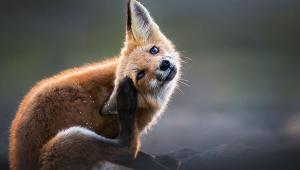Going Pro: How Photographer Bob Krist Went From "All the World's a Stage" to "All the World's a Subject"

[Column Note: Most people come to professional photography by traveling a familiar route: from an early fascination with cameras, to photo classes and courses, followed by assisting a pro to gain some real-world experience. Then comes striking out on one's own as photographer, which, if all goes well, is followed by the frequent printing of invoices. Others, however, arrive at a pro career sideways—that is, coming at it from another occupation. The stories these "second career" pro photographers tell tend to be quite interesting, even inspirational. And those stories are what this new online column, titled Going Pro, is all about.]
By any measure, Bob Krist is a highly regarded travel photographer, acclaimed for his artistry, skill and, not the least, his willingness to share his knowledge of the art, craft and business of imaging.
But once upon a time, he was traveling in a very different direction.
"I wanted to be an actor," Krist says, "and the beginnings of the desire to shoot travel came from being with a theater group on tour in Europe. Acting is night work, and during the day I'd roam around and take pictures in these wonderful cities."
Photography began to have an even greater appeal when, after stints at various theater companies, he found he was earning more money taking headshots of his fellow actors than he was as a performer. Then, in the mid-1970s, when Krist heard that a local New Jersey newspaper was looking for photographers, he jumped at the chance to earn a solid $140 a week.

Within a few years, the idea of a stage career had faded as he began to pick up corporate photography assignments that he could handle on days off from the paper. Soon he was an ex-newspaper photographer with a nice little corporate photography career shooting industrial stories in the photojournalistic style of his newspaper work.
"But," he says, "I didn't want to do just that. I'd lived abroad and traveled, and I had the travel and photography bug." Not only that, he knew he could deal with the demands of the job.
"There are a lot of people who are accomplished photographers," Krist says, "but if they're not in familiar surroundings, with their favorite assistant and favorite coffee shop nearby, they get thrown. But I knew I could function pretty well in places in which I could barely, or not at all, speak the language. I was used to functioning in the midst of chaos. That's one of the biggest qualifications of a travel photographer—to be in a strange place, to be uncomfortable, and yet still function."

Aiming for the Top (and Reaching It)
With that in mind, he aimed right for the top. "I used the fact that I'd won a New Jersey press photographer of the year award the last year I was on the paper to get an appointment with Bob Gilka, the director of photography at National Geographic."
Krist went to see Gilka with ten story ideas that would take him to all the wonderful places he wanted to go, like French Polynesia and the islands of the South Pacific. "And, of course, they were the assignments the top Geographic shooters would get," Krist says. "Gilka almost laughed me out of the office.
"None of my story ideas really worked until the last, at the bottom of the list: 'The New Jersey No One Knows.' In those days the magazine used to do state profiles, and Gilka said, 'We need to do a New Jersey story, and I can't give that job away, so why don't you see what you can do with it.'"

Of course Krist didn't know how to do a National Geographic story; he certainly didn't have any idea of the level of commitment needed. Plus he was still doing corporate assignments while working on the Geographic piece.
"Ultimately Gilka had to bring in another photographer," he says, "so I shared photography credit for the story. In those days almost everyone screwed up their first Geographic assignment, and in those days you could. But I learned what it took."
The Move to National Geographic Traveler
He continued to shoot for National Geographic until National Geographic Traveler launched. "I went to Gilka and said I'd like to work for them," Krist says. "I had a family, and at Traveler I'd be away three weeks on a story, not three months. It meant that I wouldn't work for National Geographic magazine anymore, but working for Traveler was great: three weeks here and there to top travel locations, and I was building an unbelievable stock collection."
He was also establishing an enviable record of publication, not only for his photographs but also for his travel photography columns. "I've had a column in a national magazine, without a break, since 1986: Travel + Leisure, National Geographic Traveler, Popular Photography, and now Outdoor Photographer."

Lately he's been heading off into new territory. "I'm moving toward video shooting and production for non-profits and NGOs, plus some work for universities." His video interest began when the camera companies added video capability to their still cameras. "I've been a movie buff all my life, and I like to tell stories. With video, the amount of control of the story is unprecedented—I film it, I direct it, I'm the editor."
You might say that for Bob Krist, the roles keep coming. "I'm adaptable," he says, "and because photography was my second art form, I was never as serious about my photography as I was about my acting. I looked at it as a fun thing to do to earn money."
Which is one sure way of judging the wisdom of a career move.
Bob Krist's website, bobkrist.com, offers a collection of his still and video work, plus access to his blog, Old Man in Motion.




















































